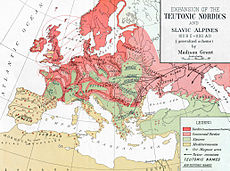- White Croats
-
White Croats White Croats (Chrobatia) on a map of the Holy Roman Empire around the year 1000. According to the map the land called Chrobatia is inhabited by the Vistulans and Lendians/Lechites, and/or near to Adriatic sea - Kingdom of Croatia. Regions with significant populations Silesia Lesser Poland Bohemia Languages Lechitic
 "Expansion of the Teutonic Nordics and Slavic Alpines" — Further Nordic expansion, as well as the Alpines. NB: Anthropological studies consistently identified Early Slavs to be actually dolicocephalic and fair haired, i.e. "Nordic".[1][2]
"Expansion of the Teutonic Nordics and Slavic Alpines" — Further Nordic expansion, as well as the Alpines. NB: Anthropological studies consistently identified Early Slavs to be actually dolicocephalic and fair haired, i.e. "Nordic".[1][2]
White Croats (Byelohravati) is the designation for the group of Slavic (Croatian) tribes, of which seven tribes led by 5 brothers (Kluk, Lobel, Muhlo, Kosjenic and Hrvat) and 2 sisters (Buga and Tuga) migrated to Dalmatia (the coastal part of today's Croatia) as part of the migration of the Croats in the 7th century, being invited to settle on this vastly depopulated area by Roman (Byzantine) Emperor Heraclius (610–641) in order to establish a shield against Avars for his state. Their homeland, defined by Edward Gibbon as "the inland regions of Silesia and Lesser Poland", has occasionally been referred to as White Croatia.[3] The term "white" among nomadic peoples of euroasiatic steppes meant "western", the rest of directions being named: red - "south", black - "north" and green - "east".
In the late 10th century, one of the White Croats states, the duchy of Libice, was ruled by Slavnik's dynasty. In 995 Czech warriors of the Vršovci family from Bohemia attacked and murdered the Slavnik's (d. 981) descendants at Libice. Three surviving brothers: Soběslav (Sobiebor) (the eldest, at that time at war against Obotrites as the duke of the Polans Boleslav's and German emperor Otto III's ally), Vojtěch (later the Christian saint and the martyr) and Radim Gaudentius sought shelter in territory under the rule of Boleslav the Brave, with whom the Slavnik's family had friendly relationships, as Slavnik's duchy tried to maintain its independence from Prague Přemyslid dynasty. Soon the war between the Polish duke and Czechs' ruler, Boleslav III the Red, broke out (this time after Vršovci family extermination by Czech prince, the remnants seeking refuge in... Poland), leading the Polish Boleslav the Brave to having a temporary control of Prague. Soběslav, living in Poland after the Libice massacre of his family, was killed by Czechs defending a bridge near Prague shielding the retreat of Polish forces from the Czech capital in 1004.
The White Croats territory could have been quite vast, it is possible that it included land as far as Kiev (now Ukraine).[citation needed] Its exact location is still the subject of discussion, as well as their genesis. Some historians[who?] present opinions, that ancient Croats were of Scytho-Sarmatian origin.
It is interesting to add that according to some American documents from the beginning of 20th century there were about 100,000 immigrants to the US born around Krakow who declared themselves to be Bielo-Chorvats, i.e. White Croats by nationality.[4][citation needed]
See also
References
- ^ From Kossina to Bromley. Ethnogenesis in Slavic Archaeology. Florin Curta. Pg 206. .. the local Slavs of the prehistoric period, as seen from the archaeological evidence, were fair haired people with elongated skulls
- ^ Carleton S Coon. The Races of Europe. Chapter VI, section 7 "Iron Age Peoples. "The evidence of literary sources makes the Slavs of nordic stature and pigmentation, that of osteology makes them the same in the metrical and morphological sense"
- ^ Croatia 802-1102. World History at KMLA, November 7, 2004. Accessed 4 September 2009.
- ^ U.S. Senate, Reports on the Immigration Commission: Dictionary of races or peoples, Washington D.C., 1911, pp. 40, 43, 105.
External links

This European history-related article is a stub. You can help Wikipedia by expanding it.

